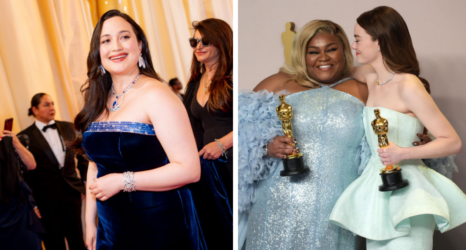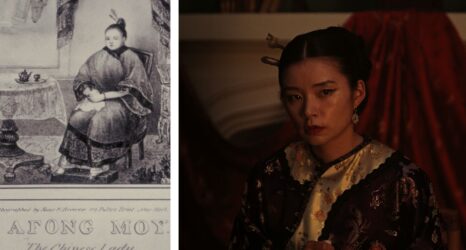The recent #OscarsSoWhite controversy drew attention to the lack of diversity in Hollywood and prompted changes to the Academy of Motion Picture Arts and Sciences’ membership rules. Producers of the annual awards show, which airs this weekend, also responded by boldly declaring that this year’s event “will be the most diverse ever”—though one look at the latest group photo of the Academy Awards nominees belies that notion.
On top of its racial homogeneity problem, the 2016 Oscars also have a gender problem. In an egregious nominating move, Alicia Vikander, the female lead at the center of transgender love story The Danish Girl, was nominated for Best Supporting Actress instead of Best Actress; her male co-star, Eddie Redmayne, received a Best Actor nomination (despite the fact that her character has more screen time than his). Indeed, the British Independent Film Awards nominated Vikander in the Best Actress category, as did the Golden Globes. So what’s wrong with Oscar?
Higher-ups at Focus Features, the film’s distributor, reportedly decided to campaign for Vikander as supporting actress instead of best actress because they thought it would increase her chances of winning. That move was seen by many as a purposeful category fraud, yet the Academy still slotted her into the supporting category while fully embracing her male costar.
The Oscars made a big, gendered mistake.
The Danish Girl is the true story of two married painters, Gerda Wegener (played by Vikander) and Einar Elbe (played by Redmayne), a trans woman who becomes Lili Elbe over the course of the film. As the movie progresses, Einar first begins to crossdress at Gerda’s request—for a painting—then, as Einar discovers his true self, we follow Gerda’s path to support her spouse and eventually take Lili as her muse.
Not to spoil the drama, but Gerda’s love and struggle to understand Einar/Lili are the driving force of the film.
Trans people have been increasing in visibility since the debate over how to categorize transgender identity in the Diagnostic and Statistical Manual of Mental Disorders (DSM) began in the 1990s. Fourteen years of debate and discussion transpired before the change for trans classification from Gender Identity Disorder to Gender Dysphoria took place in 2013. The change was significant because transgender identity was no longer seen as a “disorder” to be fixed. It remains in the DSM in order to facilitate health care, but dysphoria is a non-punitive diagnosis that does not suggest that those who fall into this category are aberrant or sick.
The discussions around the classification of trans identity in the DSM coincided with the first Hollywood movies depicting trans characters. Several won Oscars, including 1992’s The Crying Game, which received three Academy Awards in 1993 including Best Actor Stephen Rea, and 1999’s Boys Don’t Cry, for which Hillary Swank won Best Actress in a Leading Role.
Importantly, however, those earlier films had plots that were driven by violence. When a character was “revealed” as a trans person, they were harmed in some way. Following the introduction into the DSM of the term Gender Dysphoria, we finally see in The Danish Girl a compassionate depiction of a trans character. We also see a woman, Gerda Wegener, who responds to her spouse with a range of non-violent emotions—including inspiration and support—instead of violence.
To be sure, the film omitted that Gerda was lesbian or bisexual and had an open relationship with Einar/Lili that allowed her to live as a queer person. Plus, some accounts suggest that the couple behaved more like sisters than spouses or lovers, but in the film Gerda is portrayed as a straight, faithful wife who never leaves her husband; her famous lesbian erotica paintings are never mentioned in the film. But portraying a trans love story on screen—without violence—is both subversive and transformative in Hollywood, where diversity is tokenistic at best. The film, based on the novel by David Ebershoff, dramatizes one of the first trans surgeries on record. It also opens up conversations about human dignity, and sympathetically portrays trans people. And Boy Meets Girl actor Rebecca Root is one of the first transgender actors to play a non-transgender character. So identity politics are recognized.
All of The Danish Girl’s nominations matter because films that receive Oscar nods garner greater publicity, and many people watch these films simply on the basis of their nominations. But designating Vikander as supporting actress rather than best actress diminishes not only Vikander, but the role women play in Hollywood. It is essential that the Oscars make changes not only in the membership of its nominating committee, but also in its nominations for award categories.
Academy President Cheryl Boone Isaacs has asked “the elephant in the room“—racism—to “leave.” It’s time for Oscar to see the many elephants it’s dealing with. Gender is one of the most obvious elephants, increasingly ignored over the last decade according to a Women’s Media Center report. Acknowledging these elephants might make Oscar once again a statue of honor.
Get Ms. in your inbox! Click here to sign up for the Ms. magazine newsletter.
Photo of Alicia Vikander courtesy of Gage Skidmore licensed under Creative Commons 2.0





